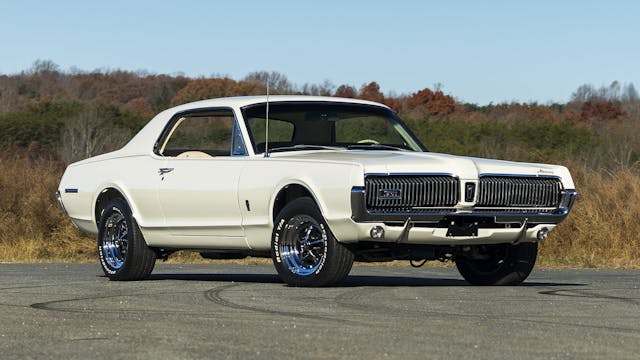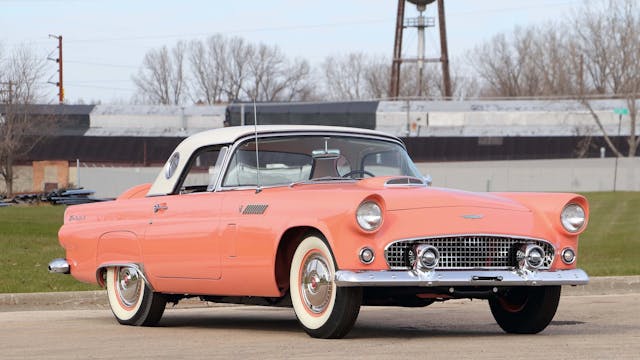These 4 American classics are becoming more attainable
After collectors (and speculators) scramble to purchase the next hot vehicle, they leave a pocket of affordability in the market behind them—a segment in which cars are bought to be driven, and buyers aren’t in it for the money. As prices seem to creep ever upward, car collectors often find themselves reflecting, “I could have bought one of those years ago for half what they sell for now.” Leaving aside the regrets of established collectors, such cars exist as a bright spot for those who’ve saved for that dream nostalgic ride and aren’t buying it as an investment.
Collectibles such as the homegrown ones we’ll discuss here typically haven’t received a body or frame transplant. They wear their original chrome, roll on stock wire wheels, and display the same trunk and hood ornaments as they did 20 or 50 years ago. We dug into our data and found four models, spanning six generations of style, whose prices have dropped in the past two years. The same amount of red, white, and blue cool—for less.
1967–70 Mercury Cougar

Average #2-condition value, excluding XR-7 and XR-7G trims: $41,300 (down from $45,300 in 2019)
The Mercury Cougar was based on the Ford Mustang, but it was also “touched by the Continental” and given more luxurious appointments. This added luxury added to the price, and when fully optioned, the Cougar came close to the Ford Thunderbird, at $4461. It took the XR-7 trim with all options to ratchet the price that high, but the Cougar could easily become downright expensive in-period.
However, as long as you don’t need an XR-7 or the four-barrel 390, Mercury Cougars are becoming more and more attainable. Excluding the most exotic packages, the average #2-condition Cougar—across all other engines and trim options—fell from $45,300 to $41,300 in the last year alone. Even the base cars came with a V-8, so there’s no need to worry about these models disappointing in the driving excitement department. Let speculators stick with the XR-7 and XR-7G trims; you can pick up a #2-condition 1969 or 1970 base model in the mid-teens ($14,300 or $15,600, respectively). Want to upgrade to the 351-equipped Eliminator? #2 values still fall under $30K.
1955–57 and 1958–60 Ford Thunderbird

Average #2 (Excellent) condition value, 1955–57: $74,500 (down from $81,000 in 2018)
Average #2-condition value, 1958–60, excluding coupe: $43,100 (down from $51,800 in 2018)
The Ford Thunderbird is a model name that sounds cool—cooler than Chevrolet Corvette, if you ask (you didn’t) for my British opinion. The T-bird came about as a response to Chevrolet’s Corvette and, thanks to market positioning and board-room decisions, it has gone through numerous style changes in the eleven generations since.
The first two T-bird generations fought valiantly against the Corvette, and, decades later, they still face stiff competition against Chevy’s fiberglass sports car. As a result, up-market buyers are getting picky and will only pay a premium for T-birds in superlative condition with the hottest options. This trend means that the best-of-the-best T-birds, such as the E- and F-code cars, are fairing reasonably well; less-desirable T-birds experience less speculation, making them comparatively more attainable.
A base 1957 T-bird in #2 (Excellent) condition was $61,400 two years ago and now sits at $41,600—a 32 percent decrease. (In contrast, a base 1957 Corvette in #2 condition has increased by 4.3 percent in the same time, and values now hover above $90K.) If you’re interested in 1958–60 T-birds, you can enjoy even more of a discount: The average #2-condition example rings in well below its 1957 counterpart, at $23,200.
1961–64 Chevrolet Impala

Average #2-condition value: $37,600 (down from $42,000 in 2018)
The Impala is another world-renowned model name whose prices have been slowly falling into the attainable range. Big-name collectors may be paying attention to heavyweight Impala trims like the Z11 Lightweight and keeping their values unobtainable; but more common Impalas have recently become far more accessible. The cars seeing the biggest corrections are the iconic big-block 409s, whose values have decreased 11 percent in the last two years. Impalas carrying the 283- and 327-cu-in engines, on the other hand, have only slipped 6 percent. Buyers can get into a well-recognized model that epitomizes ’60s swagger for less than they could a few years ago.
1946–47 and 1948–54 Hudson Super

Average #2-condition value (1946–47): $27,700 (down from $37,100 in 2018)
Average #2-condition value (1948–54): $33,200 (down from $35,900 in 2018)
Hudsons have typically been attainable collectibles rather than collector gold mines (50 percent of Hudsons are worth less than $25,000 in #2 condition), but they have a low-slung style that is all their own. Post-war Supers have a distinctive fastback design and a low ride height that can make a passerby wonder whether the roof is chopped. Passenger space still remains generous, however, thanks to floors that drop beneath the top of the frame rails.
Cars from the ’50s have been a cold spot in the market for some time; 42 percent of #2-condition vehicles from that decade haven’t seen their values budge in the last three years. (In comparison, only 14 percent of #2-condition vehicles from the ’70s experienced this plateau.) Despite their lackluster market performance, and lack of widespread name recognition, ’50s cars don’t deserve the bad rap they often get. They’re still fun cars to own and drive—in fact, I would argue you’re getting more fun per dollar. Why pay extra for a more recognizable name when the rarer car will get you more looks?
Markets are always moving, and it’s not always up. Remember, cars are meant to be enjoyed!
Like this article? Check out Hagerty Insider, our e-magazine devoted to tracking trends in the collector vehicle market.


